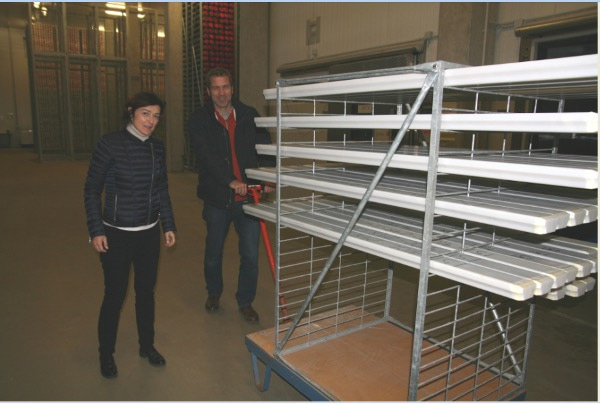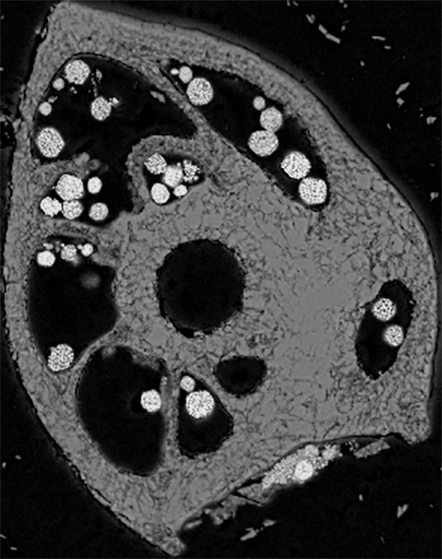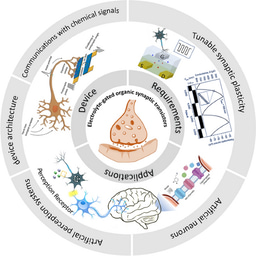
What can be a potential side effect of thawing ice in addition to liberating viruses [1], bringing back to life ancient plants [2] and exposing the oldest fossils yet known [3]? Research suggests that thawing ice could also affect significant methane reserves beneath Antarctica or Greenland ice sheets today. In 2017, Giuliana Panieri and Jochen Knies started to take sediment samples from Hole 912A, which was drilled during the Ocean Drilling Program (ODP) Leg 151 in the Arctic Ocean. They could not imagine their results would show the oldest episode recorded of methane leakages in the Arctic Ocean dated back to the Pleistocene. And together with Sunil Vadakkepuliyambatta, Carsten J. Schuber and Amicia L. Lee, they provided an exciting reconstruction of how the process could have been.

The Arctic Ocean naturally emits methane, a more potent greenhouse gas than CO2. Arctic methane reservoirs consist of free gas and gas hydrates trapped in the sediments. Gas hydrates are frozen solids of methane gas in a cage of water molecules. They are highly susceptible to pressure and temperature changes and can destabilise if one of the two, or both parameters, change. In the Arctic Ocean sediments, free gas and gas hydrate are abundant. Their potential to respond to climate change makes it imperative that we understand their sources, stability, and fate. Several investigations have tried to quantify how much methane and gas hydrates reside in polar marine sediments[4]. This is particularly important now when the release of greenhouse gas methane seems to correlate strongly with the melting of ice sheets and glaciers [5]. Still, to understand what might happen in the future to a significant carbon pool stored as hydrates under melting glaciers and grounded ice, we need to understand what has happened in the past.
In this work, we investigated borehole material drilled during Ocean Drilling Program (ODP) Leg 151, Hole 912A (79°57.557’N, 5°27.360’E, 1037 m water depth) located on the southern Yermak Plateau (Fig. 1) in the Arctic–Atlantic gateway region. During the Pleistocene mega-scale tabular icebergs or ice sheets were grounded on the Yermak Plateau where high pressure and low temperature have favoured the sequestration of methane and heavier natural gases in hydrate form. The results of our investigation answer two compelling research questions: when and why methane in the Arctic started to release from the seafloor?

SEM image and backscatter electron (BSE) images from cross-sections of the benthic foraminifera Cassidulina teretis show the presence of rounded clots formed by micrometric pyrite crystals precipitated inside the test. The specimen in this image is ca 150 microns in diameter.
We found that microorganisms like foraminifera and microbes left traces indicative of past methane leakages at the seafloor. Foraminiferal-derived stable carbon isotope and source-specific biomarker analyses reveal three main methane leakage episodes that occurred prior to and across the mid-Pleistocene transition: from ~1.6 to 1.5 Ma, during the tipping point of the first Barents Sea shelf-edge glaciation and across the MPT, at the onset at ~1.2 and the end of the midpoint at ~0.7 Ma, coinciding with a significant increase in ice volume of the Eurasian ice sheets. The three inferred main seafloor methane emission episodes are labelled as ME I, ME II and ME III (Fig. 3). The source of methane is believed to be derived from deep sediments, corresponding to old carbon reservoirs [6]. Recent modelling results in the study region revealed that gaseous hydrocarbons, originating from Miocene-aged terrestrial organic matter, accumulated in early Pleistocene sedimentary sequences and have been episodically released at the seafloor since ~1.5 Ma [7]. Our seismic data at Site 912 support a deep methane source, showing a vertical fluid migration system transporting fossil hydrocarbons from greater depths.
To discover what caused the leakages, we simulated the dynamics of the gas hydrate stability zone between 0.7 and 2.0 Ma, incorporating transient variations in sea level [8] and varying sedimentation rates [9]. We found that shelf-edge glaciations and associated reactivation of faults and fractures trigger methane release at the seafloor during episodes ME I, ME II and ME III, indicating that glacial forebulge formation during extensive ice growth and decay caused extensional fracturing, resulting in fault damage of potential gas accumulations underlying the study area[7]. Hence, extensive glacially driven forebulge formation and ice wastage during numerous Pleistocene glacial–interglacial cycles have potentially caused large-scale methane release at the seafloor

Mid-Pleistocene methane release on the Yermak Plateau, NW Svalbard. a. Conceptual model of glacial intensification (~1.6–1.5 Ma) and MPT ice sheet grounding (~1.0 to ~0.8 Ma). The locations of ODP Sites 910 and 912 are indicated. b. Upon glacier retreat, hydrate dissociation and fault reactivation contributed to intense methane release at the seafloor during ME I, ME II and ME III. c. Present-day environment in the study area, where the stable isotope compositions (δ13C) of foraminifera and biomarker analysis from ODP Hole 912A sediments indicate evidence of past methane release (not to scale). High-amplitude reflections in seismic data indicate methane in the sediments below the Gas Hydrate Stability Zone (GHSZS).
Whether leaking gas from old carbon sources contributed to an enhanced atmospheric methane concentration once the first shelf edge ice collapsed ~1.5 Ma years ago remains unresolved. While Greenland ice cores are still underexplored, methane from old carbon sources has been absent in Antarctic ice cores since the last deglaciation [10]. Most of the methane in these ice cores is inferred to be derived from decomposing recently formed organic carbon, such as plants and soil. Given the substantial size of old carbon reservoirs in the Arctic [4] and widespread leakage following the last deglaciation [11] until today [12], the apparent small effect of this source on global climate fluctuations remains a mystery.
1. Lemieux, A., et al., Viral spillover risk increases with climate change in High Arctic lake sediments. Proceedings of the Royal Society B: Biological Sciences, 2022. 289(1985): p. 20221073.
2. Yashina, S., et al., Regeneration of whole fertile plants from 30,000-y-old fruit tissue buried in Siberian permafrost. Proceedings of the National Academy of Sciences, 2012. 109(10): p. 4008-4013.
3. Allwood, A.C., Evidence of life in Earth's oldest rocks. Nature, 2016. 537(7621): p. 500-501.
4. Gautier, D.L., et al., Assessment of Undiscovered Oil and Gas in the Arctic. Science, 2009. 324(5931): p. 1175-1179.
5. Lamarche-Gagnon, G., et al., Greenland melt drives continuous export of methane from the ice-sheet bed. Nature, 2019. 565(7737): p. 73-77.
6. Knies, J., et al., Modelling persistent methane seepage offshore western Svalbard since early Pleistocene. Marine and Petroleum Geology, 2018. 91: p. 800-811.
7. Daszinnies, M., et al., The Plio-Pleistocene seepage history off western Svalbard inferred from 3D petroleum systems modelling. Marine and Petroleum Geology, 2021. 128: p. 105023.
8. Miller, K.G., et al., The Phanerozoic Record of Global Sea-Level Change. Science, 2005. 310(5752): p. 1293.
9. Mattingsdal, R., et al., A new 6 Myr stratigraphic framework for the Atlantic–Arctic Gateway. Quaternary Science Reviews, 2014. 92: p. 170-178.
10.Dyonisius, M.N., et al., Old carbon reservoirs were not important in the deglacial methane budget. Science, 2020. 367(6480): p. 907-910.
11.Cremiere, A., et al., Timescales of methane seepage on the Norwegian margin following collapse of the Scandinavian Ice Sheet. Nature Communications, 2016. 7(11509): p. 1-10.
12.Skarke, A., et al., Widespread methane leakage from the sea floor on the northern US Atlantic margin. Nature Geoscience, 2014. 7(9): p. 657-661.
Follow the Topic
-
Communications Earth & Environment

An open access journal from Nature Portfolio that publishes high-quality research, reviews and commentary in the Earth, environmental and planetary sciences.
Related Collections
With Collections, you can get published faster and increase your visibility.
Geology of the Moon
Publishing Model: Hybrid
Deadline: Jan 31, 2026
Archaeology & Environment
Publishing Model: Hybrid
Deadline: Mar 31, 2026




Please sign in or register for FREE
If you are a registered user on Research Communities by Springer Nature, please sign in